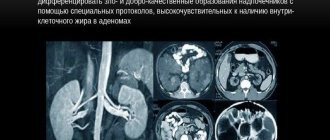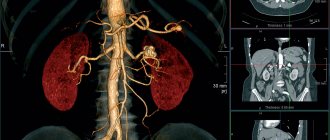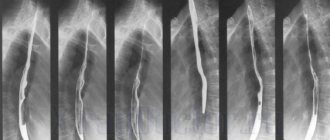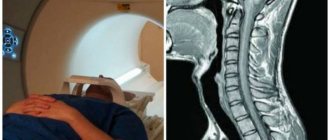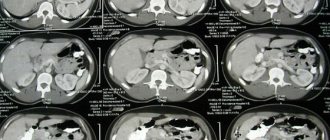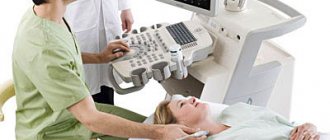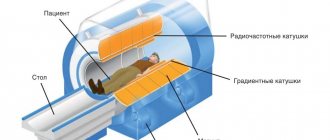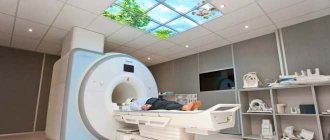Modern medicine has many opportunities for diagnosing diseases of the urinary system, and in particular the kidneys with the endocrine glands located in close proximity - the adrenal glands. One of the most convenient methods for studying these organs is ultrasound – an ultrasound examination that allows you to obtain complete information about the patient’s health status.
Moreover, the procedure is absolutely harmless, non-invasive and does not require the introduction of a contrast agent, which does not cause any discomfort or negative impact on the body to the subjects. Ultrasound of the kidneys and adrenal glands is easily tolerated by patients, does not require lengthy and complex preparation and, importantly, has an affordable price, which makes it an indispensable diagnostic tool for many branches of medicine.
Ultrasound examination of the kidneys and adrenal glands makes it possible to detect many pathologies: cysts, polyps, calculi (stones), neoplasms and developmental abnormalities. Since the procedure does not cause side effects, it can be performed an unlimited number of times, which is very convenient for monitoring the condition of patients.
Features of the kidneys and adrenal glands
The kidneys are a paired organ of the urinary system. This organ has a rather complex structure and performs the most important functions:
- excretory - removes formed urine;
- participates in the process of hematopoiesis;
- osmoregulatory - control over the volume of water;
- regulating - balancing water-salt balance;
- metabolic - participate in the breakdown of food components;
- endocrine - synthesis of hormones (prostaglandins, erythropoietin, renin).
Normally, a person does not feel the paired urinary organs. If unpleasant, painful sensations appear in the lumbar area, the development of one of the kidney diseases should be suspected.
The adrenal glands are paired endocrine glands that get their name due to their location above the top of the kidneys. The activity of the adrenal glands is regulated by the nervous system. Their main function is the production of hormones:
- corticosteroids;
- mineralocorticoids;
- glucocorticoids.
Adrenal hormones are involved in the regulation of blood pressure, metabolism, and form the body’s response to shock or stress. Violation of the physiological functions of the endocrine glands leads to the development of severe metabolic diseases.
Ultrasound allows you to examine the kidneys and adrenal glands simultaneously due to their close location. The size, position, and structure of organs are clearly determined on the monitor.
Types of kidney ultrasound
Depending on the symptoms, the doctor may prescribe one of the types of ultrasound diagnostics:
- ultrasonography - with the help of ultrasound it is possible to visualize kidney tissue, the presence of inflammatory processes, neoplasms, stones;
- Ultrasound Dopplerography is necessary to study the movement of blood in the renal vessels, determines intrahepatic thrombosis, narrowing, and damage.
Ultrasound signals, penetrating through the skin, are reflected from the organ being examined and, through a transducer, are reflected on the monitor in the form of an image.
What does a kidney ultrasound show?
Ultrasound diagnostics makes it possible to identify a number of pathological changes and processes in the kidneys:
- stones, sand;
- cystic formations;
- structural changes in tissues - a wrinkled kidney, when kidney cells are replaced by connective tissue;
- organ boundaries;
- location - in some cases, one or both kidneys may be located below, above the anatomical parameters, in the iliac region, pelvis, chest;
- foci of inflammation, purulent contents;
- congenital anomalies - horseshoe-shaped, S-shaped, biscuit-shaped kidney, absence of one organ;
- local blood flow.
What can be seen on an ultrasound scan of the adrenal glands?
The adrenal glands are examined simultaneously with the kidneys, since they are located very close. Most often, this study is performed for preventive purposes. The information obtained from an ultrasound scan of the adrenal glands can be extremely useful for the attending physician. Diagnostics indicates a number of physiological abnormalities in the structure and functioning of the endocrine glands:
- the presence of neoplasms of various origins;
- factors contributing to the development of hypertension;
- causes of infertility;
- factors causing obesity;
- causes of excess body hair;
- hormonal imbalance.
The size of the endocrine glands changes during periods of active growth. In an adult, the indicators of healthy adrenal glands are: from 20 to 70 mm in length, from 15 to 40 mm in width, from 5 to 12 mm in thickness. It should immediately be noted that normally the adrenal glands are practically not visualized using ultrasound.
The size and other characteristics of the organ are normal
In a healthy person, adrenal tissue during echolocation reflects the same signals as the fatty tissue surrounding the kidneys, so it practically merges with it. Characteristics of healthy organs:
- size of right 1.5x1.3x2 cm, left 2x1.5x1 cm, fluctuations of 0.4 cm in both directions are possible;
- homogeneous structure;
- no clearly defined capsule;
- tissue is less dense in echogenicity than kidney tissue;
- localization – superior renal plus, slightly shifted anteriorly, resembles a cap;
- the right one is shaped like a triangle, and the left one is shaped like a crescent.
Watch the video about ultrasound of the adrenal glands:
Ultrasound of the kidneys - indications
Ultrasound diagnostics of the kidneys is a completely harmless procedure with no contraindications. A planned examination is prescribed by the attending physician when:
- prolonged swelling of the lower extremities;
- urolithiasis;
- presence of signs of kidney development abnormalities;
- painful sensations in the lumbar area;
- injuries to the kidneys, abdomen, lower back;
- urinary incontinence, enuresis;
- signs of endocrine disorders;
- metabolic disorder;
- symptoms of inflammation in the abdominal cavity;
- sharp painful sensations when urinating;
- neoplasms of unknown etiology;
- persistent hypertension, difficult to respond to drug therapy;
- detected abnormalities in urine tests;
- symptoms of infectious or inflammatory diseases.
Separately, it is worth mentioning about men. For them, ultrasound of the kidneys is a mandatory procedure for cysts and tumors of the adrenal glands, and prostate adenoma.
Diagnostic results make it possible to timely identify abnormalities in kidney function and prescribe adequate therapy.
Ultrasound of the kidneys during pregnancy
For pregnant women, an ultrasound examination of the kidneys is not a mandatory procedure. However, the period of bearing a child may be accompanied by negative symptoms, in which an ultrasound of the urinary system is indicated:
- pain in the lumbar region radiating to the perineum;
- increased blood pressure;
- signs of developing pyelonephritis, hydronephrosis;
- the appearance of pronounced edema;
- changes in urine tests.
In addition, kidney ultrasound is periodically prescribed to women who were diagnosed with diseases of the endocrine system and urinary organs before pregnancy. Ultrasound rays are not capable of harming the fetus.
Possible contraindications
The ultrasound examination procedure is considered completely safe and does not cause serious harm to human health. However, there are also limitations to its implementation. Among them:
- pregnancy (especially late stages) - if there is a high need for research, then waves with a minimum frequency and degree of impact on the fetus are used;
- the presence of various types of skin diseases;
- serious damage to the skin.
Important! Before undergoing a medical examination, you must make sure that there are no skin pathologies. This is important in order to protect yourself from infections.
Preparing for an ultrasound of the kidneys
Examination of the urinary organs using an ultrasound machine requires certain preparation. Following simple recommendations allows you to obtain a more detailed image and complete data on the condition of the organs. When scheduling an examination, the doctor explains in detail how to prepare for a kidney ultrasound:
- 3-5 days before the diagnosis, foods that cause active gas formation are excluded from the daily diet (bread, marinades, various canned foods, fresh vegetables, fruits, spices, smoked meats, semi-finished products, dairy products, sweets);
- if possible, stop taking medications 2-3 days before the examination;
- before the ultrasound, it is strictly forbidden to drink alcohol for 3-5 days;
- Juices, carbonated drinks, coffee, cocoa, milk and fermented milk drinks are prohibited; you should only drink clean water.
Smoking is strictly prohibited before performing a kidney ultrasound. It is better to smoke the last cigarette 4-6 hours before the examination, otherwise the indicators may be distorted.
The last meal should be no later than 7-8 hours before the procedure. Immediately before diagnosis, the patient needs to fill the bladder. For this purpose, you should drink about 1 liter of still water an hour before the procedure.
Where to do it and how much does it cost?
The examination can be done either for a fee or free of charge:
Free - in a clinic at your place of residence, if, of course, it is equipped with equipment for ultrasound examinations. You will need a compulsory medical insurance policy and a referral from the treating doctor.
Paid – in private clinics or diagnostic points that provide this service.
What determines the cost of an ultrasound? There are several factors that influence the price of the procedure:
- Quality and novelty of diagnostic equipment. Modern equipment for three- and four-dimensional scanning makes it possible to more accurately determine pathologies, but it costs an order of magnitude more than conventional devices and needs to be repaid;
- Level of personnel qualifications – attracting highly qualified specialists requires increasing prices for services;
- Equipment of the clinic - if a medical organization provides the patient with everything necessary from shoe covers to disposable sheets and napkins, as well as tea and coffee, then you have to pay extra for this, which is already included in the cost of examinations;
- Distance from the city center and the region where the clinic is located;
- Reputation and reviews of the center.
For comparison, the average cost of ultrasound sonography of the adrenal glands in Moscow (from 500 rubles), St. Petersburg (about 790 rubles) and regions - (from 600 rubles)
How to do an ultrasound of the kidneys - algorithm
The patient sits on the couch in a supine position. During the procedure, he is told when to turn on his right or left side, on his stomach. As directed by your doctor, you should hold your breath, inflate your stomach, or take a deep breath. If nephroptosis is suspected, the patient is asked to stand up and the scan is performed again.
A special gel is applied to the skin, which removes the air layer between the body and the surface of the sensor. This is necessary for optimal propagation of ultrasound in tissues. The examination, as a rule, begins with the bladder, ureters, then it is the turn of the kidneys. First, a sonographic examination is performed, followed by a Doppler examination. While studying the blood flow in the kidneys, the patient hears specific sounds.
First, the patient is examined in a supine position, then asked to alternately turn on the right and left sides, and finally, lying on his stomach. In different body positions, the state of the kidney parenchyma, their position, shape, and boundaries are analyzed. The nurse records the following information in the study protocol:
- length, width, thickness of the buds;
- indicators of the pyelocaliceal system;
- parenchyma density.
After the first scan, the patient is asked to empty the bladder, after which the procedure is repeated again. At the end of the diagnosis, the gel is wiped off with napkins. The examination lasts no more than 20 minutes.
The results of a kidney ultrasound are provided to the patient in the form of black and white photographs of the monitor and a report. Neoplasms, stones, and cysts are indicated on the images with a contrast mark so that the attending physician receives all the necessary information.
Conducting research
The patient is placed on his back or on his stomach, there is not much difference in this. The lumbar region and lower abdomen should be freed from things worn on the body. After this, the doctor applies a gel composition to the projection area of the organs, with which the examination can be performed.
The adrenal glands are not visualized - what does this mean?
The hope that a specialist will be able to see two adrenal glands is negligible. As follows from statistics, the organ located on the left can be seen in fifty percent of one hundred cases. It is believed that the adrenal gland in a healthy state remains invisible, since if we talk about its structure, then it is no different from the cells of the retroperitoneal cavity. In a normal situation, it is possible to consider only the area of the intended location.
To make the scan more effective, the doctor advises taking a deep breath.
To examine the left adrenal gland, the patient is turned on the right side, and when diagnosing the right side, on the left.
Ultrasound in children is performed in the following situations:
- there is a suspicion of abnormalities in the kidneys or adrenal glands;
- in the presence of an already formed pathology, it is necessary to clarify the stage of severity, the appearance of possible complications, the spread of focal formations of a damaging nature;
- after laboratory testing, if there are contradictions or ambiguous clinical conclusions;
- if there are signs of pain.
Kidney ultrasound is normal
In the absence of pathological changes, human kidneys have the same indicators:
- length - from 10 to 12 cm;
- width - from 5 to 6 cm;
- thickness - from 4 to 5 cm;
- the density of the parenchymal layer is from 1.5 to 2.5 cm.
For any of the indicators, a difference may be observed that corresponds to the norm, but not more than 2 cm.
The normal shape of the kidneys is bean-shaped. They are located in the fat capsule, that is, surrounded by adipose tissue. Location - in the retroperitoneal space, on both sides of the spine, the upper border corresponds to the 12th thoracic vertebra, the lower - the 1st and 2nd lumbar vertebrae. Physiologically, the right kidney is located slightly lower than the left.
The normal structure of the tissue is homogeneous, there are no foreign inclusions. The renal pyramids are clearly defined. No formations are identified in the pelvis. Changes in the structure of renal tissue indicate the development of a pathological process. Intrapelvic inclusions are sand or stones that form during urolithiasis.
Changes in kidney size are recorded in chronic diseases and degenerative processes. Severe pathologies occur with the destruction of renal parenchyma cells. Neoplasms can cause hypertrophy of the urinary organs. An increase in size is characteristic of severe inflammation or congestion within the renal structures.
Decoding the results
During the study, a detailed assessment of the location, size, shape and structure of organs is carried out by comparison with normal characteristics for a certain category of patients. For example, normal kidney parameters in adults have the following values:
- length – 100-120 mm,
- width – 50-60 mm,
- thickness – 40-50 mm,
- the width of the parenchyma (kidney tissue) is 11-23 mm.
Important! During the period of bearing a child, if nagging pain appears in the lower back, decreased amount of urine, swelling, painful or difficult urination, it is especially important to undergo an ultrasound of the kidneys. This will make it possible to prevent serious complications of the mother’s condition and the risks of pathologies or death of the fetal egg.
The size of the kidneys in pregnant women should not differ from the normal values of adults. Therefore, at the slightest deviation from the standards, it is necessary to undergo a full examination of the internal organs (liver, gall bladder, pancreas and others), including blood and urine donation
In children, the size of the kidneys directly depends on height and age, and the gender of the child does not have a significant effect on these parameters. When the baby is 50-80 cm tall, ultrasound determines only the length and width of the organs. The average normal values for kidney size in children are as follows:
- length – 45-62 mm,
- width – 22-25 mm,
- thickness – 40 mm,
- parenchyma width is 9-18 mm.
The norm for the characteristics of the kidneys, determined by ultrasound, is considered to be: the organs have the shape of a bean, the left one is slightly higher than the right one, and the sizes differ by no more than 2 cm. With pathology, echo-positive areas are visualized in the organ, which indicates the presence of a calculus or neoplasm. Sometimes kidney stones can be misdiagnosed, since only stones larger than 4 mm in size are clearly identified.
Table of normal indicators for children of different ages
